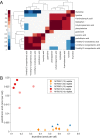Metabolite diversity among representatives of divergent Prochlorococcus ecotypes
- PMID: 37815355
- PMCID: PMC10654061
- DOI: 10.1128/msystems.01261-22
Metabolite diversity among representatives of divergent Prochlorococcus ecotypes
Erratum in
-
Erratum for Kujawinski et al., "Metabolite diversity among representatives of divergent Prochlorococcus ecotypes".mSystems. 2024 Mar 19;9(3):e0012024. doi: 10.1128/msystems.00120-24. Epub 2024 Feb 27. mSystems. 2024. PMID: 38411064 Free PMC article. No abstract available.
Abstract
Approximately half of the annual carbon fixation on Earth occurs in the surface ocean through the photosynthetic activities of phytoplankton such as the ubiquitous picocyanobacterium Prochlorococcus. Ecologically distinct subpopulations (or ecotypes) of Prochlorococcus are central conduits of organic substrates into the ocean microbiome, thus playing important roles in surface ocean production. We measured the chemical profile of three cultured ecotype strains, observing striking differences among them that have implications for the likely chemical impact of Prochlorococcus subpopulations on their surroundings in the wild. Subpopulations differ in abundance along gradients of temperature, light, and nutrient concentrations, suggesting that these chemical differences could affect carbon cycling in different ocean strata and should be considered in models of Prochlorococcus physiology and marine carbon dynamics.
Keywords: DNA methylation; Prochlorococcus; metabolomics.
Conflict of interest statement
The authors declare no conflict of interest.
Figures






References
-
- Flombaum P, Gallegos JL, Gordillo RA, Rincón J, Zabala LL, Jiao N, Karl DM, Li WKW, Lomas MW, Veneziano D, Vera CS, Vrugt JA, Martiny AC. 2013. Present and future global distributions of the marine cyanobacteria Prochlorococcus and Synechococcus. Proc Natl Acad Sci USA 110:9824–9829. doi:10.1073/pnas.1307701110 - DOI - PMC - PubMed
-
- Moran MA, Kujawinski EB, Schroer WF, Amin SA, Bates NR, Bertrand EM, Braakman R, Brown CT, Covert MW, Doney SC, Dyhrman ST, Edison AS, Eren AM, Levine NM, Li L, Ross AC, Saito MA, Santoro AE, Segrè D, Shade A, Sullivan MB, Vardi A. 2022. Microbial metabolites in the marine carbon cycle. Nat Microbiol 7:508–523. doi:10.1038/s41564-022-01090-3 - DOI - PubMed
-
- Rocap G, Larimer FW, Lamerdin J, Malfatti S, Chain P, Ahlgren NA, Arellano A, Coleman M, Hauser L, Hess WR, Johnson ZI, Land M, Lindell D, Post AF, Regala W, Shah M, Shaw SL, Steglich C, Sullivan MB, Ting CS, Tolonen A, Webb EA, Zinser ER, Chisholm SW. 2003. Genome divergence in two Prochlorococcus ecotypes reflects oceanic niche differentiation. Nat 424:1042–1047. doi:10.1038/nature01947 - DOI - PubMed
-
- Moore LR, Chisholm SW. 1999. Photophysiology of the marine cyanobacterium Prochlorococcus: ecotypic differences among cultured isolates. Limnol Oceanogr 44:628–638. doi:10.4319/lo.1999.44.3.0628 - DOI
